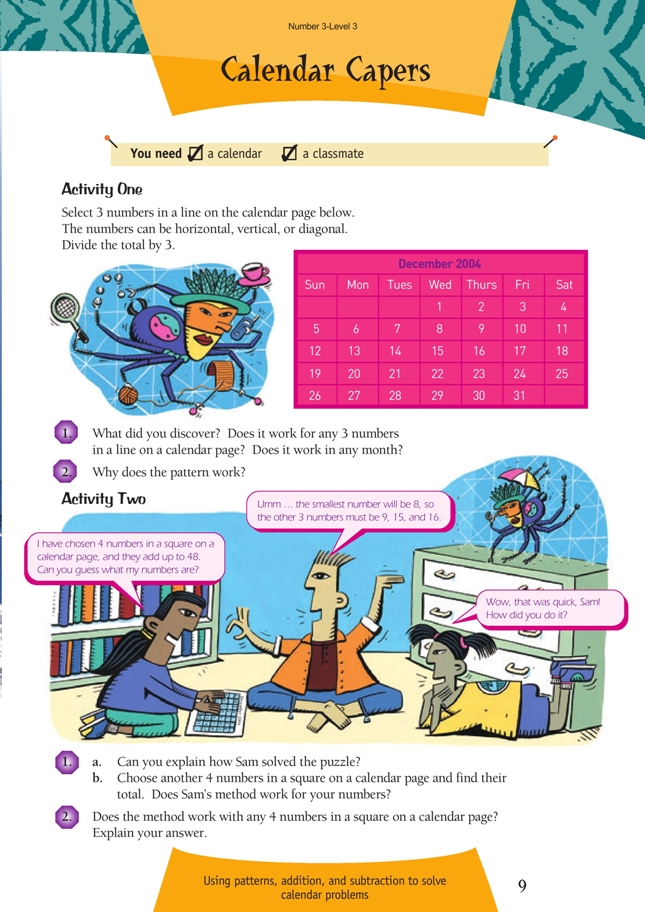This is a level 3 number activity from the Figure It Out series. It relates to Stage 6 of the Number Framework.
A PDF of the student activity is included.
Click on the image to enlarge it. Click again to close. Download PDF (254 KB)
solve addition and subtraction puzzles on a calendar
A calendar
A classmate
Activities One and Two
For these activities, students need to know their addition and subtraction basic facts, be able to divide numbers (perhaps using a calculator), find an average (mean) of a set of numbers by manipulating numbers rather than by dividing, and understand the meaning of “vertical”, “horizontal”, and “diagonal”.
The students should find this an interesting activity because there are many patterns to be found in a number array such as a calendar, and calendars are commonly used around the school and at home.
Activity One requires the students to add 3 numbers and then divide the total by 3. They should notice that the result is always the middle number of the sequence. Instead of dividing, the students may wish to “level” the numbers. For 3 numbers in sequence, this means taking an amount off the largest number and giving it to the smallest number so that all the numbers end up the same. For example, using 15, 23, and 31, take 8 from the 31 and add it to the 15 so that all the numbers become 23.
This is a great way to introduce students to the idea of a “mean”, that is, adding a set of numbers and then dividing by the number in the set: 15 + 23 + 31 = 69; 69 ÷ 3 = 23. (See also pages 4–5 of the students’ book.) The students should notice that if the numbers from the calendar are in a horizontal row, the difference between them is 1; if they are vertical, it is 7 (because there are 7 days in a week); and if they are on the top left and bottom right diagonally, the difference is 8, that is, 1 week and 1 day. If they are on the top right and bottom left diagonally, the difference is 6 (1 week less 1 day).
Activity Two is an extension of Activity One, but the students now have to discover the relationship between 4 numbers. Sam already knows the relationship and has worked it out in his head, but the students have to find out what he did.
Two possible methods that Sam could have used are explained in the Answers.
Further discussion and investigation
You could ask the students:
“Does this levelling of the mean work for 5 numbers in a row, column, or diagonal? Why or why not?”
“Are there any other sets of numbers (such as a 3 by 2 or 3 by 3 grid) that work in a similar way?”
“Do these patterns work on a hundreds board?”
“How and why is a hundreds board different from a calendar?”
Cross-curricular link
Science
The students could investigate how the calendar was developed and its relationship to the Moon and the Sun.
Answers to Activity
Activity One
1. Answers will vary, but when you add 3 consecutive horizontal, vertical, or diagonal numbers on a calendar grid (or any grid array) and divide by 3, your answer is the middle number. For example, 11 + 12 + 13 = 36. 36 ÷ 3 = 12.
This works for any 3 such numbers, so it will work for any month.
2. Answers may vary. We are finding the mean (average) of 3 consecutive horizontal, vertical, or diagonal numbers. The mean is found by “levelling” numbers to make them the same. So to find the mean of 8, 9, and 10, we take off 1 from the 10 and put it on the 8 so that all the numbers become 9. (The mean of 8 + 9 + 10 is
27 ÷ 3 = 9.)
Activity Two
1. a. Explanations may vary. One explanation is:
Sam took the 48, divided it by 4, and then took off 4 (because the mean of the numbers in a 4-grid array is always 4 more than the first number). This gave him 8, the smallest number. The next number has to be 1 more than 8 (9), the third 7 more than 8 (15), and the fourth 8 more than 8 (16). So the 4 numbers are 8, 9, 15, and 16.
Another way of explaining this is:
The 4 numbers add up to 48. In a 4-grid array, a total of 16 is added to 4 times the
first number. 48 – 16 = 32. 32 ÷ 4 = 8, which gives you the smallest number in the
square. If n = the number given (48) and s = the smallest number, then
(n ÷ 4) – 4 = s. s + 1, s + 7, and s + 8 will give you the other three numbers.
b. Numbers will vary. Sam’s method will work for any set of 4 numbers in a 4-grid array.
2. Yes. Explanations will vary. A possible explanation is:
Take any set of 4 numbers: 17 18 24 25
When we look at the numbers, we see:
17 17 + 1
17 + 7 17 + 8
If we add all these together, we get
4 x 17 + (1 + 7 + 8) = 68 + 16.
As a generalisation: Let the first number be s.
Then the next will be s + 1, the third will be s + 7, and the fourth will be s + 8.
The total will be 4 x s + 16.

